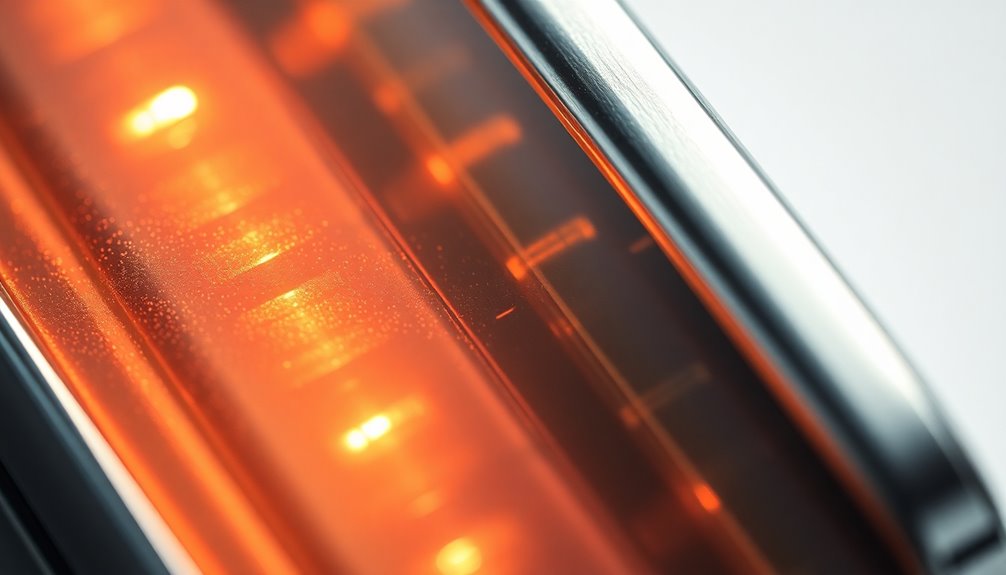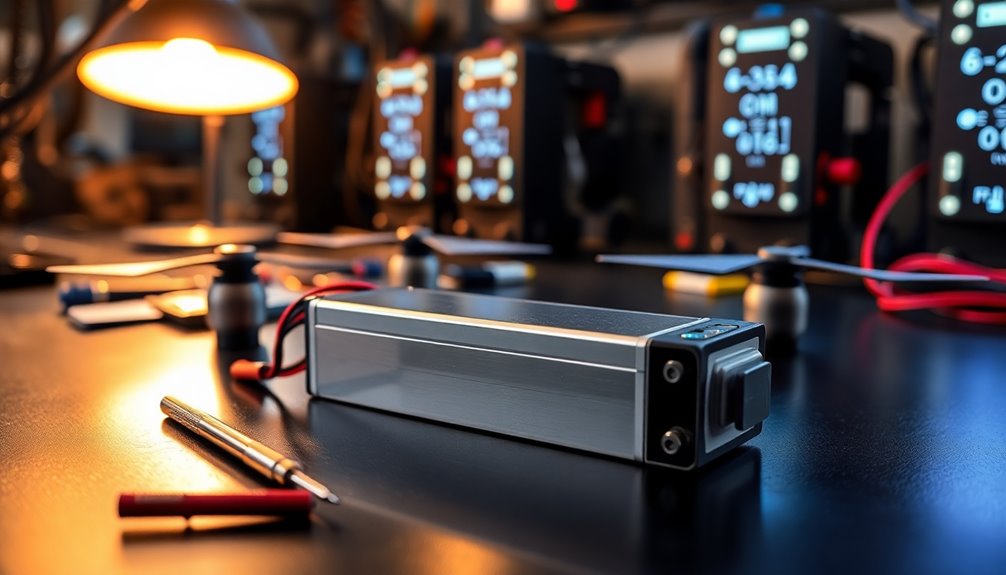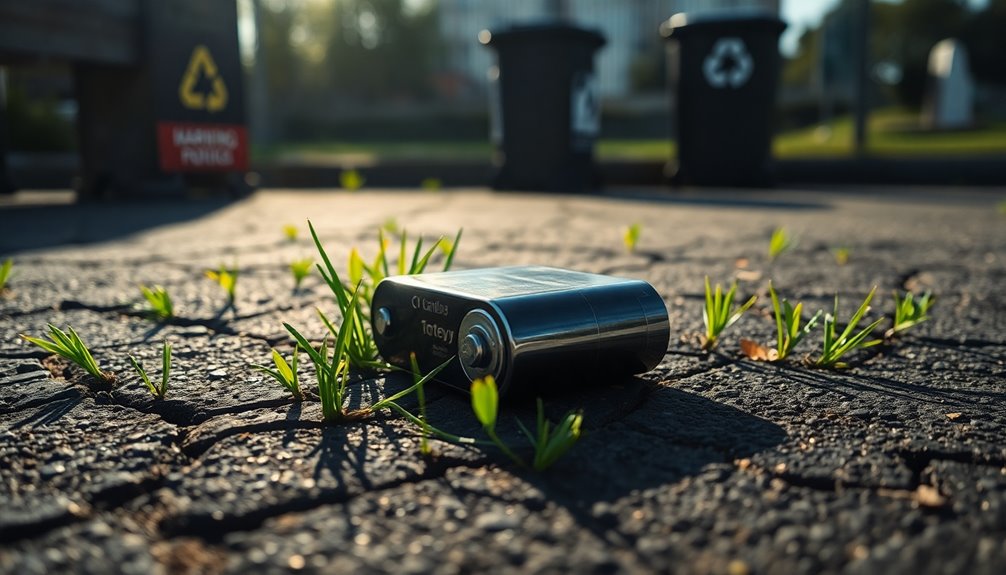Alkaline batteries are primary power sources designed for everyday devices like remote controls and flashlights. They have a composition featuring zinc and manganese dioxide as electrodes, with potassium hydroxide as the electrolyte, giving them a longer shelf life—up to 10 years! You'll find them in common sizes like AAA and AA, providing a steady 1.5V output. While they perform well for moderate power needs, they can struggle with high-drain devices. Plus, they're relatively eco-friendly as they're non-hazardous. Stick around to uncover more about their benefits, market trends, and how to properly dispose of them!
Key Takeaways
- Alkaline batteries are primary batteries made of zinc and manganese dioxide, utilizing potassium hydroxide as an electrolyte for better performance.
- They provide a consistent voltage output of 1.5V and have a shelf life of approximately 10 years, ideal for emergencies.
- Alkaline batteries are preferred for moderate power devices but may struggle with high-drain applications compared to lithium batteries.
- They are generally non-hazardous, with recycling programs in place to recover valuable materials, promoting responsible disposal practices.
- The alkaline battery market is growing, projected to reach $7 billion, driven by increasing demand in emerging markets.
Alkaline Battery Composition and Types
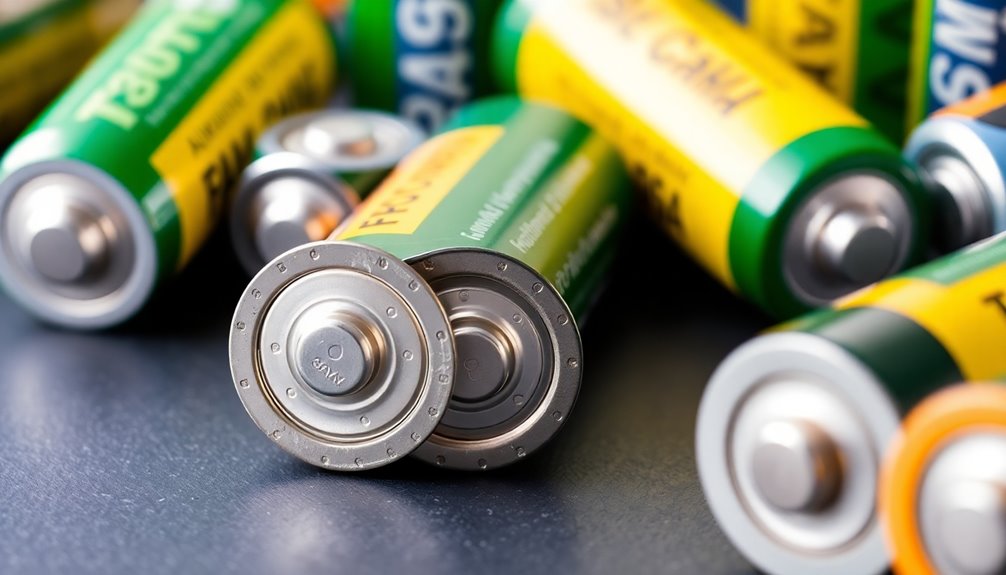
Alkaline batteries are essential power sources found in countless devices, thanks to their efficient composition.
These batteries utilize zinc and manganese dioxide as electrodes, with potassium hydroxide acting as the alkaline electrolyte. This combination gives them a higher energy density compared to traditional zinc-carbon batteries.
As primary batteries, they're designed for single-use applications and boast a long shelf life of nearly 10 years.
You'll find them in various standard sizes, including AAA, AA, C, D, and 9V, with AA being the most common.
Additionally, alkaline batteries come in button cell formats, offering a cost-effective solution for small electronics, even though they've less capacity than silver oxide or lithium alternatives.
Market Trends and Growth
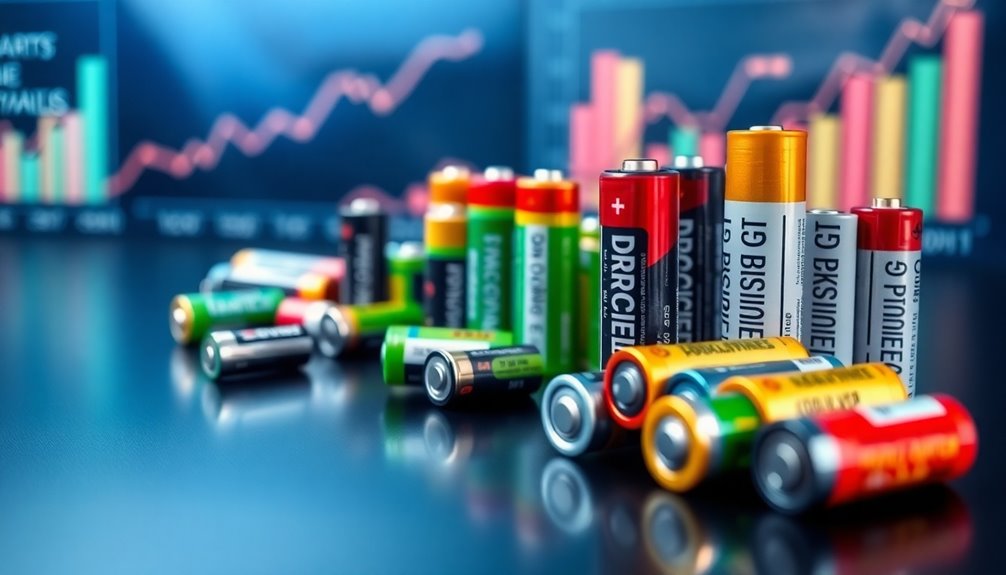
As you explore the market trends for alkaline batteries, you'll notice a significant change in regional demand, especially as Asia Pacific and Latin America move away from carbon zinc options.
Projections indicate steady growth, with revenues expected to reach up to $7 billion in the near future.
This shift not only highlights the batteries' reliability but also their increasing presence in everyday devices.
Regional Demand Growth
With a growing reliance on portable electronics, the demand for alkaline batteries is surging, particularly in evolving regions like Asia Pacific and Latin America.
These developing regions are moving away from carbon zinc batteries due to the superior effectiveness of alkaline batteries in powering consumer electronics.
North America and Europe still dominate the global alkaline battery market, accounting for about 65% of market revenues.
However, the expected compound annual growth rate (CAGR) of 3% to 4% indicates robust growth potential worldwide.
- Increased use in consumer electronics
- Expanding market in Latin America
- Strong shelf life of 2-4 months
- Emerging markets in the Middle East and Africa
Transition From Carbon Zinc
The shift in consumer preferences is becoming increasingly evident, particularly as more individuals opt for alkaline batteries over carbon zinc alternatives. Alkaline batteries boast superior energy density and long shelf life, making them more reliable for everyday devices. This trend is reflected in their impressive 65% share of the primary battery market. As consumer demand rises, regions like Asia Pacific and Latin America are moving away from outdated carbon zinc technology. The chemical reaction in alkaline batteries reduces internal resistance, enhancing performance and longevity.
| Feature | Alkaline Batteries | Carbon Zinc Batteries |
|---|---|---|
| Energy Density | High | Low |
| Long Shelf Life | ~10 years | ~2-3 years |
| Market Share | 65% | 35% |
Market Projections and Insights
Market projections for alkaline batteries indicate a promising future, driven by increasing consumer demand and technological advancements. The global alkaline battery market is expected to grow at a CAGR of 3% to 4%, generating revenues between $6.5 billion and $7 billion.
Key insights include:
- Alkaline batteries dominate the primary battery market with a 65% market share.
- Average lifespan of alkaline batteries guarantees steady replacement demand every 2-4 months.
- Long shelf life, nearly 10 years, enhances their appeal for emergency preparedness.
- North America and Europe remain major revenue contributors, while Asia Pacific shows strong growth potential.
With their steady voltage output and reliability, alkaline batteries are well-positioned for continued success in the market.
Performance Comparison With Other Batteries
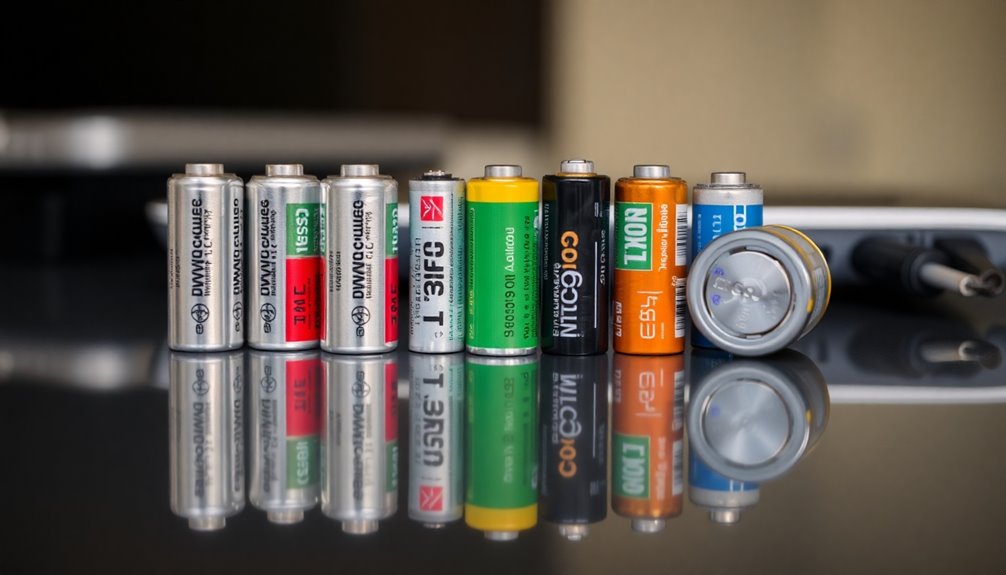
When comparing alkaline batteries to lithium and nickel-based options, you'll notice some key differences in performance.
While alkaline batteries work well in low-drain devices, lithium batteries outlast them considerably in high-drain situations.
Nickel-based batteries also shine under heavy use, often outperforming alkaline in sustained high current loads.
Alkaline vs. Lithium Batteries
How do alkaline and lithium batteries stack up against each other in terms of performance? When you consider voltage, lifespan, and energy density, the differences become clear.
- Voltage: Alkaline batteries deliver 1.5V for quick bursts, while lithium batteries maintain a steady 3.0-3.7V.
- Lifespan: Lithium batteries last two to three times longer than alkaline batteries, making them more cost-effective over time.
- Self-Discharge: Alkaline batteries self-discharge at about 2% per year, in contrast to the much lower self-discharge rate of lithium batteries.
- High-Drain Devices: Lithium batteries excel in high-drain devices, efficiently handling higher current demands, unlike alkaline batteries.
Ultimately, your choice may depend on the application and frequency of use.
Alkaline vs. Nickel Batteries
While both alkaline and nickel batteries serve essential roles in powering various devices, their performance characteristics differ considerably, especially in demanding applications.
Alkaline batteries are often heavier, which can affect usability in lightweight devices. In high-drain applications, they tend to deplete faster, providing less energy capacity than nickel-based batteries.
Although alkaline batteries self-discharge at about 2% per year, nickel-based batteries can lose nearly all their charge within 12 months of inactivity.
Alkaline batteries excel in standby power scenarios, like smoke alarms, due to their long shelf life and reliability. However, for frequent use in devices such as cordless tools, nickel batteries are more effective.
Despite this, alkaline batteries remain a cost-effective option for disposable applications.
Environmental Impact and Recycling

Although alkaline batteries are regarded as non-hazardous waste, their environmental impact shouldn't be overlooked. Proper recycling is essential for maximizing their benefits. By recycling alkaline batteries, you contribute to resource recovery and waste reduction, which enhances sustainability practices.
Here are some key points to keep in mind:
- Alkaline batteries don't contain mercury, making disposal easier.
- Recycling recovers valuable materials like zinc, manganese, and steel.
- The European Union mandates that alkaline batteries shouldn't mix with domestic waste.
- Awareness of recycling options minimizes environmental impacts and supports responsible waste management.
Historical Development of Alkaline Batteries
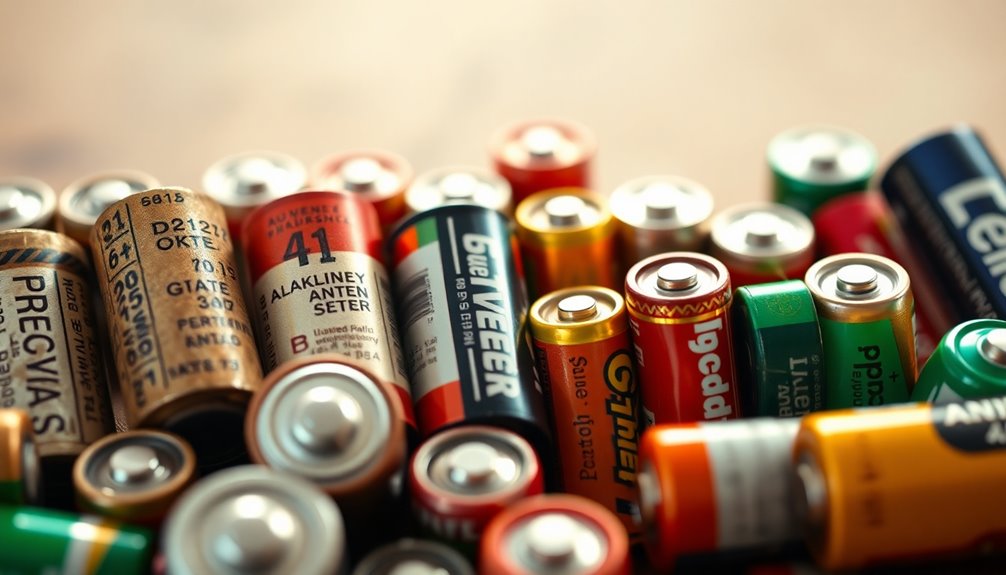
Alkaline batteries have come a long way since their inception in the late 19th century. The first developed versions by Waldemar Jungner in 1899 and Thomas Edison in 1901 laid the groundwork for future advancements.
In the 1950s, Lewis Urry invented the modern alkaline battery, greatly enhancing the performance of alkaline batteries used in consumer electronics. A US patent was filed on October 9, 1957, and granted in 1960, solidifying Urry's contribution with Union Carbide Corporation.
Initially, these batteries included mercury amalgam to improve shelf life, but environmental legislation prompted reductions in this component.
Since their commercial debut in 1959, alkaline batteries have become the dominant technology in the market, thanks to their reliability and major advantages over other battery types.
Maintenance and Storage Tips

To guarantee your alkaline batteries perform at their best and last as long as possible, proper maintenance and storage are essential.
Follow these tips to maximize shelf life and minimize issues:
- Store batteries in a cool, dry place at room temperature to reduce self-discharge.
- Avoid extreme temperatures, as they can hinder alkaline electrolyte activity and efficiency.
- Keep batteries in their original packaging until use to prevent contact with conductive materials that could cause short circuits.
- Regularly check for leakage or corrosion in devices and replace affected batteries promptly to protect performance.
Frequently Asked Questions
What Are the Basics of Alkaline Batteries?
Alkaline batteries are essential for many everyday devices.
They're non-rechargeable and typically provide a 1.5-volt output, which drops as they discharge.
You'll find them in various sizes, like AA, AAA, C, D, and 9V, with AA being the most common.
These batteries last longer than zinc-carbon types, often up to ten years, and they're easier to dispose of since they're classified as non-hazardous waste.
Just remember, once they're drained, it's time to replace them.
Are Alkaline Batteries Bad for You?
Alkaline batteries aren't inherently bad for you, but you should handle them with care.
They're generally safe and mercury-free, making them a better option for consumers. However, if a battery leaks, the potassium hydroxide inside can irritate your skin or eyes.
Keep them out of reach of children, as ingestion can cause serious harm.
Always store and dispose of them properly to minimize any risks associated with improper handling.
What Is Special About Alkaline Batteries?
What's special about alkaline batteries is their impressive energy density and long shelf life.
You'll find they're perfect for a variety of devices, from remote controls to toys.
They're also less likely to leak, thanks to their unique composition, making them more reliable than some other options.
Plus, their mercury-free nature means you can dispose of them more easily and safely, making them a go-to choice for many everyday needs.
What's the Difference Between an Alkaline Battery and a Regular Battery?
Imagine two knights in a battery kingdom: the alkaline knight wields a powerful sword, while the regular knight struggles with a dull blade.
You'll find alkaline batteries deliver more energy and last longer, boasting up to 3000mAh compared to the regular's meager 1000mAh.
Alkaline knights are single-use champions, while their rechargeable counterparts can fight over and over.
Plus, they're eco-friendly, making them the noble choice in your quest for power!
Conclusion
To sum up, alkaline batteries have come a long way since their invention, becoming a staple in our daily lives. While many believe they can't be recycled, that's not entirely true; they can be processed properly to minimize environmental impact. By choosing alkaline batteries and following storage tips, you can maximize their lifespan and performance. So, the next time you reach for a battery, remember that your choice matters—not just for your devices but for the planet, too!




